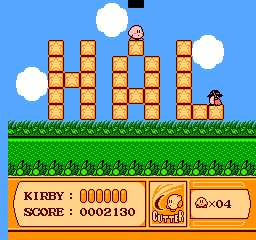Kirby's Adventure
| Kirby's Adventure |
|---|
|
Also known as: Hoshi no Kirby: Yume no Izumi no Monogatari (JP)
|
Kirby's Adventure is the sequel to Kirby's Dream Land, which set the standard for all future Kirby games with the introduction of copy abilities as well as being a much longer game than its predecessor. It's also one of the most graphically-advanced games released for the NES, released near the end of the console's life cycle. It has a great amount of unused content, too – some of which would be recycled for future Kirby games.
It was remade in 2002 for the Game Boy Advance as Kirby: Nightmare in Dream Land, followed by a 3DS port in 2011 as 3D Classics: Kirby's Adventure, using the original NES resources with minor differences like depth effects.
Contents
Sub-Pages
| Prerelease Info |
| Bugs |
| Debug Rooms Rooms used for testing purposes. |
| Unused Rooms Rooms that didn't make it in the final version of the game. |
| Unused Palettes Color palettes left by the wayside. |
| Unused Objects Not so much the objects themselves, but the way they behave. |
Unused Ability
![]()
![]()
![]()
According to the game's director, Masahiro Sakurai, in a Developer Interview of Kirby's Adventure, several abilities were cut out of the final game, including one "where Kirby could shrink down". These tiles of a tiny Kirby are found in sprite bank 8C, along with the graphics for the Mike and Ball abilities. The slightly larger Kirby would have been used for a shrinking animation (Kirby does the raised hand pose for abilities like Crash and Light, ones that aren't demonstrated right away).
The shrinking ability might have been replaced with the UFO power. All of the other ability tiles are close together in graphic banks 80-99, while the UFO Kirby graphics are located in bank C6. UFO is also the last normal ability by ID, further supporting this theory.
Twelve years later, this ability would finally be realized in Kirby & the Amazing Mirror as the "Mini" ability...although, in that game, you can't slide while using this power.
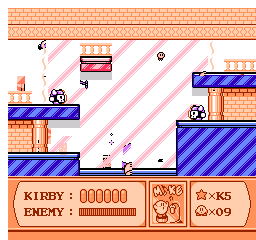
These sprites can randomly appear on-screen from abusing the "Mike Overflow" glitch, as seen here.
Unused Songs/Unheard Segments
Kirby's Dream Land Title Theme
Track 16 (10 hexadecimal in-game) in the Sound Test is the Kirby's Dream Land title screen theme. This might be a leftover from when Kirby's Adventure was planned to be an NES port of Dream Land.
Fountain of Dreams Cutscene Music (Unheard Segment)
The song that plays in the Fountain of Dreams cutscene prior to facing Nightmare only plays for around 19 seconds before stopping. However, letting it play for longer reveals that the last part loops 2 times before the main instrument is removed, leaving only percussion playing.
Intro-less Stage Themes
| To do: Upload the intro-less sound files - both to confirm it's real and so we can listen to them. |
Tracks 1, 4, 18 (12), 28 (1C), 31 (1F), 33 (21), 41 (29), 43 (2B), and 51 (33) are most of the level music without their intros. Intro-less stage themes would later be featured in the game's remake, Kirby: Nightmare in Dream Land.
Unused Graphics
| To do: There are graphics in the Japanese version of the game for "ほしのカービィ!" (Kirby's title) meant to show up at the end of the Kirby drawing intro that go unused. |
Invincibility Icon
An untranslated duplicate of the invincibility icon, stored in bank 14. The icons normally used by the game are stored in banks 40-4B.
Water Tiles
![]()
Graphics for seven different water tiles of this style, stored in banks 24-27. Only two appear in-game.
![]()
What they would have looked like animated.
Cannon Icon
This icon is stored with the rest of the ability icons and was meant to be used when Kirby hops into a cannon, but doing so doesn't change the icon. It is shown during Mix's ability roulette wheel, but due to how fast the wheel moves it's impossible to get a good look at it without using something like an emulator's frame advance feature. It was eventually restored in the European versions of the game, and the 3DS remaster 3D Classics: Kirby's Adventure. No equivalent exists in Kirby: Nightmare in Dream Land.
Unused Stage Graphics
Banks 13 and 50 contain an unused dark room tileset! They are assigned to graphics set 22 and would have used palettes 8B-91, all of which are stored immediately after the ones used in-game (graphics set 21, palettes 84-8A).
| Mock-up screen, dark | Same screen, lit |
|---|---|
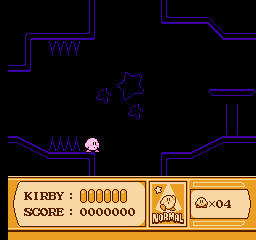 |
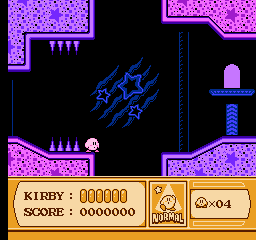 |
Early Level Hub HUD
The level intro tileset seems to contain graphics for an early version of the level hub HUD. This is much darker than the HUD used in-game and the graphics are very different.
7th Stage Door
A 7th stage door graphic. No level has more than 6 stages, rendering this unused.
Minibosses
Two of these three frames aren't shown in-game at all. The Poppy Bros. Sr. graphic is similar to his normal death frame, but his feet are on the ground. The Rolling Turtle graphic is strange – perhaps he could hide in his shell during battle?
The frame for Mr. Frosty is actually used, but it's very difficult to see normally: If he doesn't have enough room behind him to walk backwards to toss an ice cube (by carefully tricking him into stopping right before hitting a wall), he will fall on his head with this animation, and cause him to ram forwards into the wall.
Crane Game
Apparently, the crane game was originally supposed to give you three credits, as evidenced by the presence of a "3" with the rest of the numeral graphics. Setting address $7BB to 03 as the game loads will give you three chances, as well as display this unused graphic, though it will still only count up to two Kirby plushes at the end of the game.
Unused Text
At ROM address 0x7BAC9, the unused text string "~Star General ~" is found among the titles used for the file selection screen. The actual game goes from "~Swift Hunter ~" to "~ Star Herald ~" upon reaching 40% completion.
HAL Room
At the end of the first room in Stage 2 of Vegetable Valley is the name "HAL" in the form of many Star Blocks; however, it is inaccessible due to the Warp Star beforehand which forces the camera to stop going to the right. However, if you manage to overload the game's sprite memory (e.g., by throwing Cutters while several enemies are present) as the Warp Star scrolls into view, it will fail to load, allowing you to see the HAL blocks. This room can also be accessed by unloading the Warp Star by walking away from it to the point where it is offscreen repeatedly.
Oddly, a Broom Hatter is present on the "L". There is also a door just off the top of the screen that leads to the next area, though it cannot be reached normally. This is due to the way Warp Stars work; a regular exit representing the Warp Star's destination must be placed within the level, though these are typically not visible.
Many HAL rooms, including this one, are also present in Kirby: Nightmare in Dream Land, but they are inaccessible without codes.
Hidden HAL rooms would eventually become a staple of the Kirby series starting with Kirby Super Star Ultra, with these ones actually being accessible, though very well hiddenǃ
Revision Differences
| To do: Document any code differences in the other regional releases. |
There are two major revisions of Kirby's Adventure. The first of these was released in Japan and was the basis for the original US revision 0. The second was released as US revision 1 and was the basis for all of the other localized releases (Canada, Europe, France, and Germany).
Text String
The peculiar string RGKK_SetStillX can be found in US revision 0 at ROM address 0x7FFF0. This location seems to contain random data in every other version.
Intro Story
| Revision 0 | Revision 1 |
|---|---|
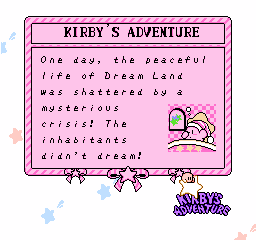 |
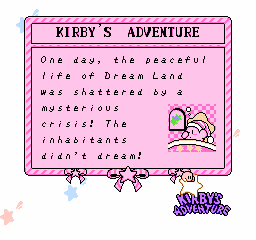 |
The spacing of the "KIRBY'S ADVENTURE" text is incorrect on the first few story pages in US revision 0. This was fixed in revision 1.
File Select
The "Li'l Traueler" ranking in US revision 0 was corrected to "Li'l Traveler" in revision 1.
Mike Counter Underflow
In the Japanese version and US revision 0, Kirby can trigger a Star Switch with the Mike ability if he is touching the very edge of the sprite's hitbox. If this is done when Kirby has one Mike left, the counter will underflow, which then causes the Mike to exhibit a variety of interesting graphical glitches (as seen here). This was fixed in revision 1 by preventing the Mike from interacting with the switch.
Regional Differences
| To do: Cover the French and German ability icons, some of them have significant design differences from the English ones |
| Japan | International |
|---|---|
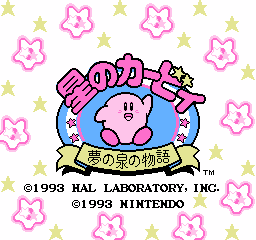 |
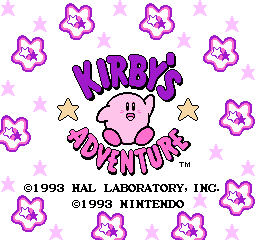 |
The Japanese version features a different, much more elaborate logo, matching the Japanese box art. The international version uses a variation of the logo seen on its box art. Two yellow stars were added to fill the empty space, and the Kirby sprite and trademark symbol were moved a bit. Since the background stars use the same palette as the logo, their color was also changed, going from pink and yellow to purple and pink.
| Japan | International |
|---|---|
 |
 |
Burning was renamed Fireball in the international English version. This localized name would only be used for one other game, Kirby's Dream Course, with it being referred to as Burning in all regions in most future Kirby games, including Kirby: Nightmare in Dream Land (though Kirby's Block Ball and Kirby 64: The Crystal Shards would call it Flame and Burn internationally, respectively).
| Japan | International |
|---|---|
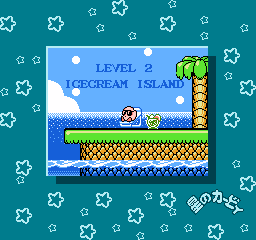 |
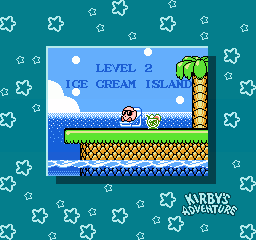 |
Aside from the universal logo change, "Icecream Island" was changed to the slightly more natural sounding "Ice Cream Island". The edit puts the text a bit off-center. Also, notice how the stars on the bottom of the level intro screen were rearranged. The same name change is made in Kirby: Nightmare in Dream Land.
| Japan | International |
|---|---|
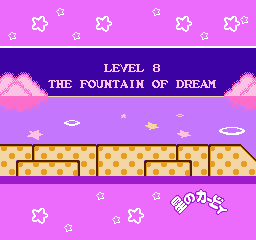 |
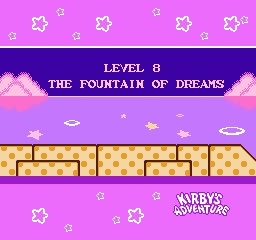 |
Similarly, "The Fountain of Dream" was changed to "The Fountain of Dreams", which also puts the text a bit off-center. The same name change is made in Kirby: Nightmare in Dream Land.
Heavy Mole
In the Japanese version, Kirby's vitality is restored when the scene transitions to the Star Rod area after defeating Heavy Mole, the boss of Yogurt Yard. This causes it to also be restored in V.S. Boss! mode after beating Heavy Mole. In the international versions, this is changed so that Kirby's vitality is restored after he exits the stage and moves on to Orange Ocean so that it is not restored in V.S. Boss! mode. This fix is not present in 3D Classics: Kirby's Adventure, while Kirby: Nightmare in Dream Land 's Boss Endurance fixes the issue in every region.
Music
Vegetable Valley Intro
| International | Europe |
|---|---|
Several tracks in the game were edited slightly to compensate for timing differences on 50Hz televisions, usually pitching up and changing the speed, but for some reason, the intro to Vegetable Valley was rewritten entirely. This change is only made in the European NES version (also used for the Wii Virtual Console), and not in subsequent European releases where the North American version is used by default.
Intro-less Stage Themes
| To do: Confirm this? It's been a while. |
In the international releases of the game, the various stage themes each have two entries in the sound test: one with the intro, and one without. Some of them are not present in the European version.
Other
The European translations appear to be based on the English version. The French version is the only one that properly uses the Cannon icon (now renamed Canon), which was only restored for other regions in the 3D Classics version.
- Featured articles
- Featured main articles
- Pages missing developer references
- Games developed by HAL Laboratory
- Pages missing publisher references
- Games published by Nintendo
- NES games
- Pages missing date references
- Games released in 1993
- Games released in March
- Games released on March 23
- Games released in May
- Games released on May 1
- Games released in December
- Games released on December 1
- Games with unused areas
- Games with hidden development-related text
- Games with unused enemies
- Games with unused objects
- Games with unused graphics
- Games with unused items
- Games with unused abilities
- Games with unused music
- Games with debugging functions
- Games with regional differences
- Games with revisional differences
- Pages with a Data Crystal link
- To do
- Kirby series
Cleanup > Pages missing date references
Cleanup > Pages missing developer references
Cleanup > Pages missing publisher references
Cleanup > To do
Games > Games by content > Games with debugging functions
Games > Games by content > Games with hidden development-related text
Games > Games by content > Games with regional differences
Games > Games by content > Games with revisional differences
Games > Games by content > Games with unused abilities
Games > Games by content > Games with unused areas
Games > Games by content > Games with unused enemies
Games > Games by content > Games with unused graphics
Games > Games by content > Games with unused items
Games > Games by content > Games with unused music
Games > Games by content > Games with unused objects
Games > Games by content > Pages with a Data Crystal link
Games > Games by developer > Games developed by HAL Laboratory
Games > Games by platform
Games > Games by publisher > Games published by Nintendo
Games > Games by release date > Games released in 1993
Games > Games by release date > Games released in December
Games > Games by release date > Games released in December > Games released on December 1
Games > Games by release date > Games released in March
Games > Games by release date > Games released in March > Games released on March 23
Games > Games by release date > Games released in May
Games > Games by release date > Games released in May > Games released on May 1
Games > Games by series > Kirby series
The Cutting Room Floor > Featured articles
The Cutting Room Floor > Featured articles > Featured main articles
The Cutting Room Floor > Unimportant Awards > NES games







